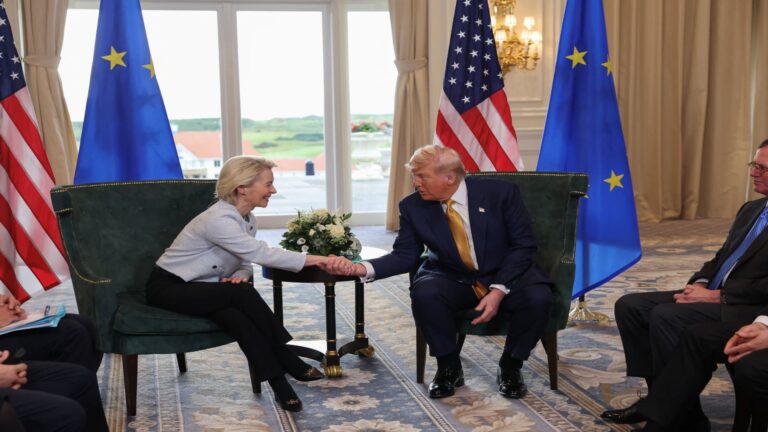U.S. President Donald Trump shakes hands with European Commission President Ursula von der Leyen, after the announcement of a trade deal between the U.S. and EU, in Turnberry, Scotland, on July 27, 2025.
Evelyn Hockstein | Reuters
President Donald Trump announced Sunday that the U.S. reached a trade deal with the European Union, following pivotal discussions with European Commission President Ursula von der Leyen days before the Aug. 1 tariff deadline.
Trump said that the deal imposes a 15% tariff on most European goods to the U.S., including cars.
Some products, including aircrafts and their components, some chemicals and pharmaceuticals, will not be subject to tariffs, von der Leyen said in a briefing after the agreement was announced. She also said that the new 15% tariff rate would not be added to any tariffs already in effect.
The 15% tariff rate is lower than the 30% rate Trump had previously threatened against the United States’ largest trading partner, but higher than the 10% baseline tariffs the EU was hoping for.
Trump said that the 27-member bloc also agreed to purchase $750 billion worth of U.S. energy and invest an additional $600 billion worth of investments into the U.S. above current levels.
He said that the bloc would also be “purchasing hundreds of billions of dollars worth of military equipment,” but did not provide a specific dollar amount.
“It’s a very powerful deal, it’s a very big deal, it’s the biggest of all the deals,” Trump said alongside von der Leyen.
“It’s a good deal, it’s a huge deal, with tough negotiations,” von der Leyen said after the meeting.
While questions remain about the specific details and timeline of the EU investments, the agreement marks a pivotal moment for Trump, following weeks of uncertainty surrounding the U.S.-EU trade talks.
Trump during a press conference before his meeting with the European leader said that there was a 50-50 chance they would reach a framework of a deal.
Brussels had been preparing for a no-deal scenario if the trade talks devolved ahead of Aug. 1.
Lawmakers had approved a major package of counter-tariffs, which would have targeted a range of U.S. goods. The bloc also considered deploying the EU’s “Anti-Coercion Instrument,” a move seen as the trading bloc’s “trade bazooka.”
Ireland’s Prime Minister said the agreement “brings clarity and predictability to the trading relationship between the EU and the US,” according to a statement.
“It does mean that there will now be higher tariffs than there have been and this will have an impact on trade between the EU and the US, making it more expensive and more challenging,” Ireland’s Department of the Taoiseach said.
Still, the agreement “creates a new era of stability,” the statement continued.
The U.S.-EU trade relationship was valued at 1.68 trillion euros ($1.97 trillion) when taking into account both services and goods trading in 2024, according to the European Council.
While the EU recorded a surplus on goods trading, it noted a deficit in the services realm. This left the EU with an overall trade surplus of around 50 billion euros with the U.S. last year.
This is a breaking news story, please check back for updates.

